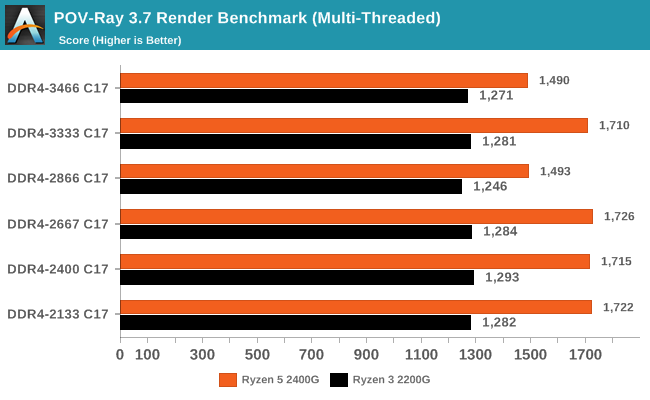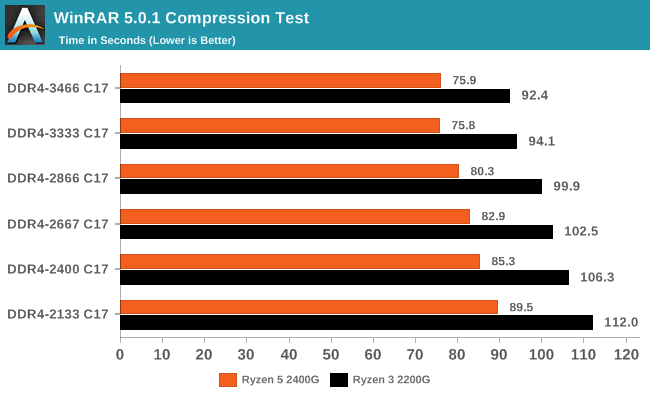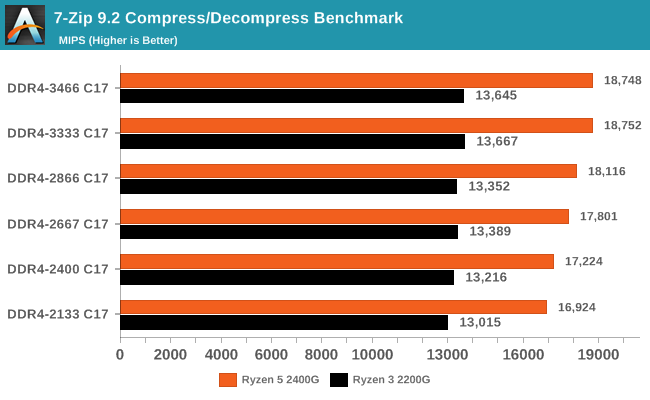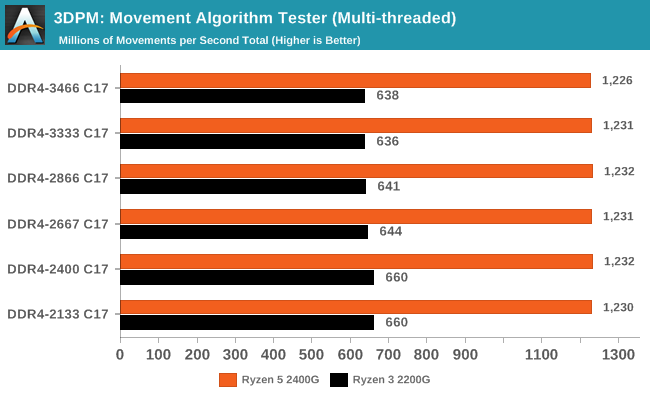Zen and Vega DDR4 Memory Scaling on AMD's APUs
by Gavin Bonshor on June 28, 2018 9:00 AM EST- Posted in
- CPUs
- Memory
- G.Skill
- AMD
- DDR4
- DRAM
- APU
- Ryzen
- Raven Ridge
- Scaling
- Ryzen 3 2200G
- Ryzen 5 2400G
CPU Performance
Rendering - Blender 2.78: link
For a render that has been around for what seems like ages, Blender is still a highly popular tool. We managed to wrap up a standard workload into the February 5 nightly build of Blender and measure the time it takes to render the first frame of the scene. Being one of the bigger open source tools out there, it means both AMD and Intel work actively to help improve the codebase, for better or for worse on their own/each other's microarchitecture.

While memory speed does influence our final rendering duration consistently by shaving seconds off, the jump from DDR4-2133 to DDR4-3333 equates to a 2% reduction overall on the Ryzen 3 2200G, although the last step from 3333 to 3466 is actually a regression. The Ryzen 5 2400G experienced a reduction of just under 4%.
Rendering – POV-Ray 3.7: link
The Persistence of Vision Ray Tracer, or POV-Ray, is a freeware package for as the name suggests, ray tracing. It is a pure renderer, rather than modeling software, but the latest beta version contains a handy benchmark for stressing all processing threads on a platform. We have been using this test in motherboard reviews to test memory stability at various CPU speeds to good effect – if it passes the test, the IMC in the CPU is stable for a given CPU speed. As a CPU test, it runs for approximately 1-2 minutes on high-end platforms.

Our results in POV-Ray 3.7 were a little hit and miss and showed irregularities at different memory clock speeds, perhaps due to the additional power required by the memory controller at higher frequencies taking away from available CPU power. This means POV-Ray isn’t really influenced more by the memory speeds themselves, although it is certainly more determined from more CPU cores and higher frequencies as the difference between the 2200G and 2400G show.
WinRAR 5.4: link
Our WinRAR test from 2013 is updated to the latest version of WinRAR at the start of 2014. We compress a set of 2867 files across 320 folders totaling 1.52 GB in size – 95% of these files are small typical website files, and the rest (90% of the size) are small 30-second 720p videos.

As the memory frequency was increased, the compression time was consistently lower going up a memory strap. With WinRAR being one of our most DRAM-affected CPU tests, we have seen this before with other CPU generations. The 2200G saw a 21% increase in throughput, while the 2400G had a +18% gain. However it is worth noting that the DDR4-3466 time was slightly slower than that of the DDR4-3333 time again.
7-Zip 9.2: link
As an open source compression tool, 7-Zip is a popular tool for making sets of files easier to handle and transfer. The software offers up its own benchmark, to which we report the result.

The 7-Zip results are interesting as with both Ryzen based APUs at the DDR4-3333 setting saw the biggest benefit in compression and decompressing. Again, the top strap in our testing was not the most performant. Overall gains were +11% for the 2400G, and +5% for the 2200G, in line with thread counts.
Point Calculations – 3D Movement Algorithm Test: link
3DPM is a self-penned benchmark, taking basic 3D movement algorithms used in Brownian Motion simulations and testing them for speed. High floating point performance, MHz, and IPC win in the single thread version, whereas the multithread version has to handle the threads and loves more cores. For a brief explanation of the platform agnostic coding behind this benchmark, see my forum post here.

With our 3DPM Brownian Motion simulator benchmark, memory frequency made little difference in increasing performance, although as our results show, the slower the memory, the better performance we experienced on the Ryzen 3 2200G. The Ryzen 2400G experienced a similar range of inconsistent and inconsequential results showing little to no improvement as the memory strap was increased.
Neuron Simulation - DigiCortex v1.20: link
The newest benchmark in our suite is DigiCortex, a simulation of biologically plausible neural network circuits, and simulates activity of neurons and synapses. DigiCortex relies heavily on a mix of DRAM speed and computational throughput, indicating that systems which apply memory profiles properly should benefit and those that play fast and loose with overclocking settings might get some extra speed up. Results are taken during the steady state period in a 32k neuron simulation and represented as a function of the ability to simulate in real time (1.000x equals real-time).

DigiCortex experienced a very subsequent increase throughout the tested memory straps on both the Ryzen APUs, with a nice jump in performance of 22% on the 2200G and on the 2400G.










74 Comments
View All Comments
iwod - Thursday, June 28, 2018 - link
When are we going to get faster memory? Haven't we stuck with DDR4 for quite long? Even with DDR5 it doesn't seems to scale well with APU's needs.Chaitanya - Thursday, June 28, 2018 - link
Biggest problem is most modules on market are still stuck with Jedec 2133Mhz and there are hardly handful of Jedec 2666Mhz kits on market. Xmp sucks and it needs to die soon. Ddr5 it seems is just a capacity solution to Ddr4 rather than a speed problem.Maxiking - Thursday, June 28, 2018 - link
I don't think you understand here what's going on. Jedec is just the standard, a set of predetermined memory speed settings Bios will run RAM at. It doesn't matter if rams are Jedec 2133 or Jedec 2666mhz, both specifications are painfully slow. When you run above those Jedec specs, you use XMP profiles. Nothing more, nothing less. If you set up rams in XMP and copy Jedec specs, they will offer the same performance.If anything, it is Jedec what sucks. It takes them years to update and create new memory standards, so DIMM manufacturers have to overclock on their own via XMP.
Samus - Thursday, June 28, 2018 - link
DDR4 for too long? It’s only been around for 4 years!Stuka87 - Thursday, June 28, 2018 - link
It was released 4 years ago, but very little used it. As I recall only Haswell-E used in in 2014. 2016 is when DD4 pretty much became the standard and mainstream chips were using it.Andy Chow - Friday, June 29, 2018 - link
How is JEDEC 2133 slow? It's 17 GB/s. If you run it in quad channel, it's 68 GB/s. I seriously doubt that bottlenecks most workloads. Just look at the 3DPM results, when you're actually doing calculations, and you actually decrease performance with faster memory, probably because the JEDEC standards aren't defined so the RAM and the memory controller aren't behaving perfectly which random io read/write queues. And I bet if you used registered 2133 DDR4, you would actually see a performance increase, even through there's 2-3 more controllers in the way.JEDEC is obviously very prudent and conservative when defining their specs, but by no way are there current specs slow. If your workload is simple and linear (gpu, compression, encryption), then DDR4 isn't the recommended RAM type, HBM is, and the HBM JEDEC specs pre-date the DDR4 ones. DDR4 is optimized for low random io latency, whereas HBM is optimized for sequential io bandwidth. Most datacenter and server workload needs are io latency bottlenecked, not bandwidth bottlenecked, so I doubt on the DDR side the next generations will increase pre-fetch sizes above what they already are, regardless of how that would benefit games, encryption or compression (the last two are asic solved in the corporate world).
bananaforscale - Saturday, June 30, 2018 - link
This. There are *very* few workloads that benefit from more than two channels. Heck, Ryzen 2 is less memory speed dependent than Ryzen was. Now, *latency* could go way down and it would benefit stuff.invasmani - Tuesday, July 10, 2018 - link
Not accurate and 2666MHz Cas 9 for example on a good memory kit has a amazing performance index of 296. I run 2000MHz Cas 7 w/ a performance index of 285 it's actually better overall than the kit is rated for at DDR4 3200MHz Cas 16 by a long shot.Ket_MANIAC - Friday, June 29, 2018 - link
How long exactly have you been stuck with DDR4 and what would you do with DDR5 on a desktop, if I may?Andy Chow - Friday, June 29, 2018 - link
No. We had DDR3 for 11 years before DDR4 came out. DDR4 came out in 2014. DDR5 won't come out before 2019 at the earliest, the specs aren't even final as of today, so you don't really know what you are talking about.The reason that DDR ram will never be good with graphics compared to GDDR is because DDR is optimized for cisc operations while GDDR is optimized for risc operations. You could run GDDR on an apu (the ps4 does this), but this makes the CPU run slower.
An apu will always be a sub-standard solution performance wise. It's a solution that aims to be good for low-cost, low-power consumption, or small form factor. It will always deliver mediocre performance.